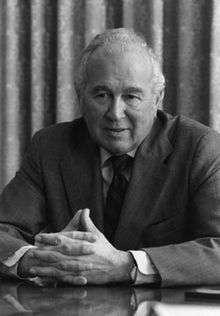Malcolm Toon
Malcolm Toon (July 4, 1916 – February 12, 2009)[1] was an American diplomat who served as a Foreign Service Officer in Moscow in the 1950s, 1960s, and 1970s, during the Cold War, ultimately becoming the ambassador to the Soviet Union.
Malcolm Toon | |
|---|---|
 | |
| United States Ambassador to Czechoslovakia | |
| In office July 31, 1969 – October 11, 1971 | |
| President | Richard Nixon |
| Preceded by | Jacob D. Beam |
| Succeeded by | Albert W. Sherer, Jr. |
| United States Ambassador to Yugoslavia | |
| In office October 23, 1971 – March 11, 1975 | |
| President | Richard Nixon Gerald Ford |
| Preceded by | William Leonhart |
| Succeeded by | Laurence H. Silberman |
| United States Ambassador to Israel | |
| In office July 10, 1975 – December 27, 1976 | |
| President | Gerald Ford |
| Preceded by | Kenneth B. Keating |
| Succeeded by | Samuel W. Lewis |
| United States Ambassador to the Soviet Union | |
| In office January 18, 1977 – October 16, 1979 | |
| President | Gerald Ford Jimmy Carter |
| Preceded by | Walter John Stoessel, Jr. |
| Succeeded by | Thomas J. Watson, Jr. |
| Personal details | |
| Born | July 4, 1916 Troy, New York |
| Died | February 12, 2009 (aged 92) Pinehurst, NC |
Life
Toon was born July 14, 1916, in Troy, New York, where his father was a stonecutter, shortly after his parents had emigrated from Scotland.[2][3] The family returned to Scotland when he was 6, before then resettling in Northborough, Massachusetts. Toon received an A. B. Degree from Tufts University in 1937, and an M.A. degree from the Fletcher School of Law and Diplomacy of Tufts University in 1938.[2] He served in the United States Navy from 1942 to 1946.[4] In the Pacific Ocean theater of World War II, he was a PT boat skipper, and received the Bronze Star Medal for valor.[5]
He was married to Elizabeth Jane Taylor (died 1996) and they are interred at Arlington National Cemetery.[2] Eight years after his death, Toon's obituary was published by The New York Times.[2]
Career
After the war, Toon joined the United States Foreign Service, receiving postings in Poland, Haiti, and Hungary, before being trained in the Russian language at the Embassy of the United States, Moscow in the 1950s.[2]
In 1965, Toon had become the U.S. embassy's third-ranking official when the Russians made accusations that was running a spy ring, which were officially denied, and he was not expelled.[2] He then became the head of the State Department's Soviet Affairs office.[2]
Toon was the ambassador to Czechoslovakia from 1969 to 1971, Yugoslavia from 1971 to 1975, Israel from 1975 to 1976, and the Soviet Union from 1977 to 1979.
He participated in SALT II talks from 1977 to 1979 and the American-Soviet Summit in Vienna in 1979. At the summit, Toon learned that President Jimmy Carter had chosen Thomas Watson Jr., a business executive, as his replacement, leading Toon to publicly criticized making ambassadors out of those without any State Department experience.[2] Secretary of State Cyrus Vance then negotiated SALT II with Soviet Ambassador Anatoly Dobrynin without Toon, causing an upset Toon to publicly question the agreement's verification procedure.[2] President Carter signed the treaty but when Soviet-American relations deteriorated he withdrew it from consideration by the U.S. Senate.[2][6]
In the 1990s, Toon co-chaired the U.S.-Russian Joint Commission on POW/MIAs with Russian general Dmitri Volkogonov. An article about Toon's briefing of the U.S. press corps in Moscow 1977-79 was published in the Foreign Service Journal in June 2011.[7]
References
- "Toon, Former Ambassador, Dies". The Pilot. February 20, 2009. Retrieved May 2, 2017.
- Goldstein, Richard (1 May 2017). "Malcolm Toon Made Waves as a Diplomat, but His Death Went Largely Unreported". The New York Times. p. B14. Retrieved 3 May 2017.
- Nominations of Carl J. Gilbert and Malcolm Toon: Hearing, Ninety-first Congress, First Session. May 5, 1969. U.S. GovernmentPrint. Office. 1969.
- Carter, Jimmy (1 January 1977). Public Papers of the Presidents of the United States: Jimmy Carter, 1977. Best Books on. pp. 715–. ISBN 978-1-62376-764-8.
- Congressional Record, V. 147, Pt. 8, June 12, 2001 to June 25 2001. Government Printing Office. November 2005. pp. 10647–. ISBN 978-0-16-075093-9.
- "Corrections: May 3, 2017". New York Times. May 3, 2017. Retrieved May 3, 2017.
- Knight, Robin (June 2011). "Malcolm Toon and the Moscow Press" (PDF). Foreign Service Journal: 39–43. Archived from the original (PDF) on August 8, 2011. Retrieved July 2, 2011.
External links
- U.S. State Department Archives (People)
- Malcolm Toon has been interviewed as part of Frontline Diplomacy: The Foreign Affairs Oral History Collection of the Association for Diplomatic Studies and Training, a site at the Library of Congress.
- Appearances on C-SPAN
| Diplomatic posts | ||
|---|---|---|
| Preceded by Jacob D. Beam |
United States Ambassador to Czechoslovakia 1969–1971 |
Succeeded by Albert W. Sherer, Jr. |
| Preceded by William Leonhart |
United States Ambassador to Yugoslavia 1971–1975 |
Succeeded by Laurence H. Silberman |
| Preceded by Kenneth B. Keating |
United States Ambassador to Israel 1975–1976 |
Succeeded by Samuel W. Lewis |
| Preceded by Walter John Stoessel, Jr. |
United States Ambassador to the Soviet Union 1977–1979 |
Succeeded by Thomas J. Watson, Jr. |
